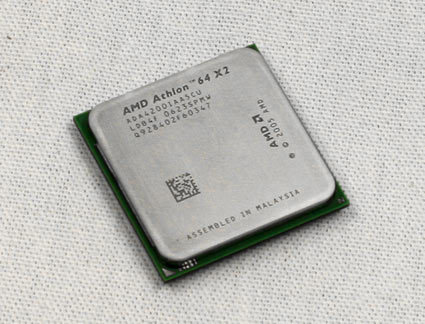Holiday Buyer's Guide 2006, Part 1: PC Components
Processors: Fast Or Furious?
With so many processor brands and model numbers, it has become increasingly difficult to select a model that fits your needs. On the one hand, everybody wants to buy something powerful, but on the other, nobody wants to spend more money than is necessary.
Among single core processors, we have AMD's Sempron and Athlon 64, and Intel's Celeron, Pentium 4 and Pentium D; we recommend that you avoid all of these today unless you get a really good deal. Go for a dual core processor, which should be either an AMD Athlon 64 X2 or an Intel Core 2 Duo processor. The Pentium D provides adequate performance, but it consumes considerably more power and thus requires better cooling than Core 2.
Go Reasonable: AMD Athlon 64 X2 4200+
The Athlon 64 X2 4200+ is one of the entry-level dual core processors from AMD, and the versions for Socket AM2 can be purchased for well under $200. Make sure you get a retail package, because these include a decent processor cooler. The X2 4200+ comes with 512 kB L2 of cache per processor core, and runs at 2.2 GHz clock speed, which provides decent processing power for games and multimedia. Please check out our Interactive CPU Charts to compare the 4200+ to all of the other X2 versions, as well as Intel's processors.
Go Ballistic: Intel's Core 2 Extreme X6800
Intel made an impressive comeback this summer. After receiving lots of negative press for its Pentium 4 and Pentium D processors - due to the large amounts of energy they consume - the release of the Core 2 Duo finally changed everything and put Intel back in control. Current Core 2 processors run at much lower clock speeds than the Pentium 4 or Pentium D (1.86 to 2.93 GHz with Core 2 vs. 3.0 to 3.8 GHz with the Pentium 4/D), but still provide much better performance - and they only require half the energy to do so.
The top model is Intel's Core 2 Extreme X6800 processor, which is manufactured in Intel's modern 65 nm process. Equipped with 4 MB of unified L2 cache (flexibly accessibly by both processing cores) and running at 2.93 GHz with a 266 MHz bus speed (FSB1066), it outperforms all the other high-end desktop processors on the market. This is true both for classic applications, as well as modern, thread-optimized software that makes full use of both processing cores.
Be prepared for the $999 price tag, but in exchange you will get the fastest CPU available, and one that easily overclocks to 3.2 GHz or more.
Get Tom's Hardware's best news and in-depth reviews, straight to your inbox.
Current page: Processors: Fast Or Furious?
Prev Page Part 1: Processors, Coolers, Motherboards, Memory Next Page Keep Cooler!
Patrick Schmid was the editor-in-chief for Tom's Hardware from 2005 to 2006. He wrote numerous articles on a wide range of hardware topics, including storage, CPUs, and system builds.



